Lesson 13
Multi-step Measurement Problems with Fractions
Warm-up: True or False: Some Number Times a Fraction (10 minutes)
Narrative
The purpose of this True or False is to activate what students know about multiplying a fraction by a whole number (\(n \times \frac{a}{b}\), in particular fractions with denominators 4, 8, and 12) and about fractions that are equivalent to whole numbers. The reasoning students do here will be helpful later when students solve problems involving fractional units of measurement in pounds, ounces, hours, and minutes.
The whole numbers and the denominators in the equations are multiples or factors of one another, so students have an opportunity to look for and make use of structure (MP7) to determine whether the equations are true.
Launch
- Display one statement.
- “Give me a signal when you know whether the statement is true and can explain how you know.”
- 1 minute: quiet think time
Activity
- Share and record answers and strategy.
- Repeat with each statement.
Student Facing
Decide whether each statement is true or false. Be prepared to explain your reasoning.
- \(16 \times \frac{1}{4} = 4\)
- \(8 \times \frac{3}{4} = 12\)
- \(32 \times \frac{2}{8} = 8\)
- \(60 \times \frac{1}{12} = 10\)
Student Response
For access, consult one of our IM Certified Partners.
Activity Synthesis
- “Can you tell whether an equation is true by looking at the sizes of the whole numbers and fractions, without performing computation? For instance, without multiplying \(60 \times \frac{1}{12}\), can we say that \(60 \times \frac{1}{12}\) can’t be 10? How?” (Yes, we know that 12 groups of \(\frac{1}{12}\) make 1, which means 120 groups of \(\frac{1}{12}\), not 60 groups, are needed to make 10.)
Activity 1: Info Gap: Noah’s School Day (Part 1) (15 minutes)
Narrative
The purpose of this activity is to introduce students to the structure of the MLR4 Information Gap routine. This routine facilitates meaningful interactions by positioning some students as holders of information that is needed by other students.
Tell students that first, a demonstration will be conducted with the whole class, in which they are playing the role of the person with the problem card. Explain to students that it is the job of the person with the problem card (in this case, the whole class) to think about what information they need to answer the question.
For each question that is asked, students are expected to explain what they will do with the information, by responding to the question, “Why do you need to know (that piece of information)?” If the problem card person asks for information that is not on the data card (including the answer!), then the data card person must respond with, “I don’t have that information.”
Once the students have enough information to solve the problem, they solve the problem independently.
The info gap routine requires students to make sense of problems by determining what information is necessary and then ask for information they need to solve them. This may take several rounds of discussion if their first requests do not yield the information they need (MP1).

Launch
- Groups of 2
Activity
MLR4 Information Gap
- Display problem card, as shown in the activity statement.
- Read the problem aloud.
- Listen for and clarify any questions about the context.
- “Some of the information you need to solve this problem is missing, and I have it here. What specific information do you need?”
- 1–2 minutes: quiet think time
- “With your partner, decide what information you need to solve the problem, and create a list of questions you can ask to find out.”
- 2–3 minutes: partner discussion
- Invite students to share 1 question at a time.
- Record each question on a display, and respond with, “Why do you need to know (restate the information requested)?” Students should provide a justification for how they will use the information before the information is revealed.
- Answer questions using only information on the data card in the narrative (do not reveal).
- Record information that is shared on the display. Give students time to decide whether they have enough information to solve the problem.
- Repeat until students decide they have enough information to solve.
- 2–4 minutes: independent work time
Student Facing

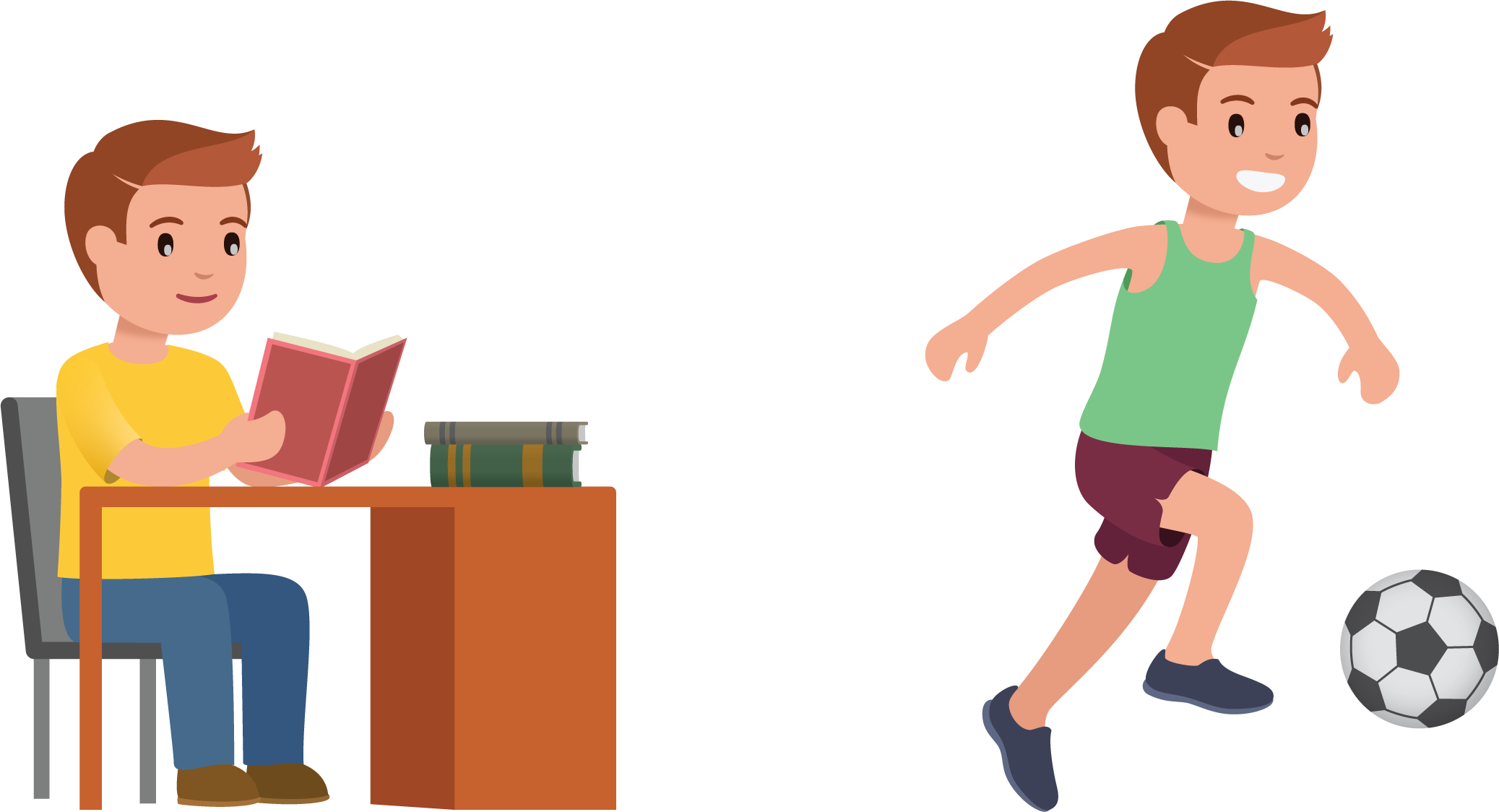
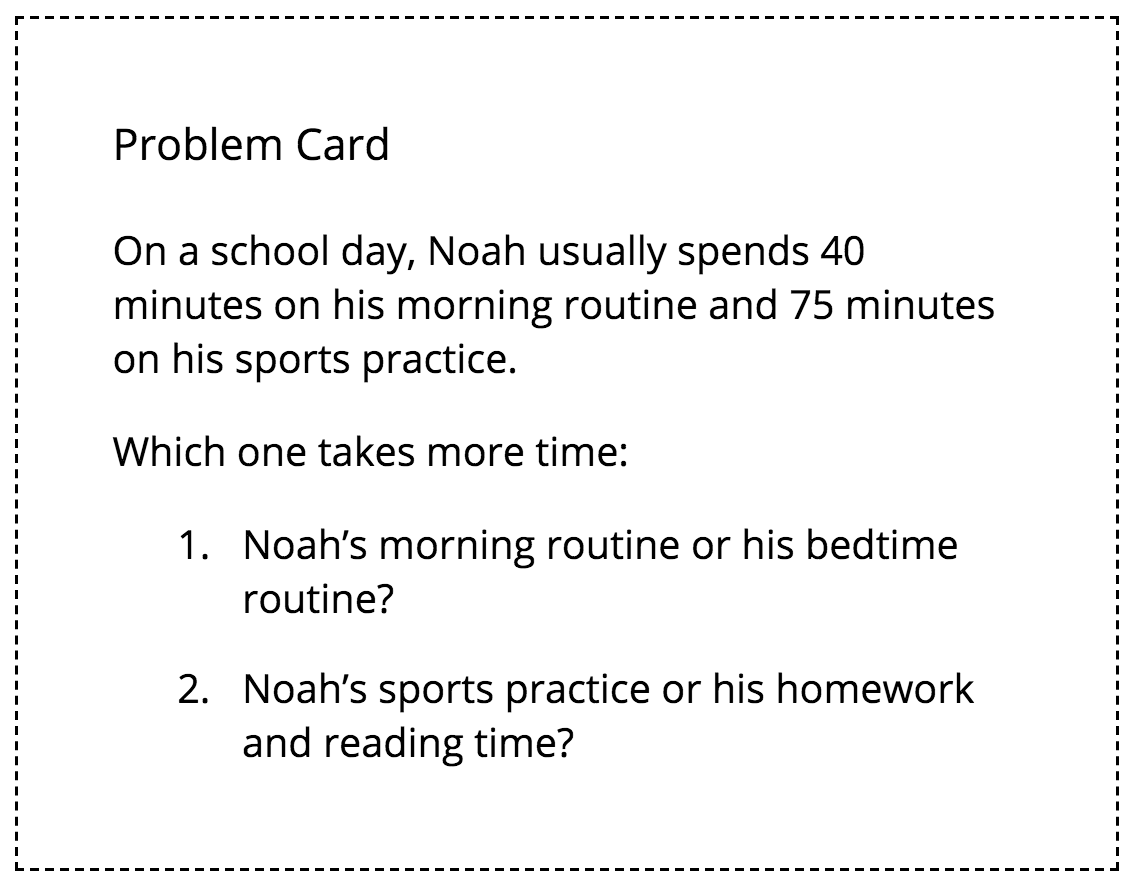
Student Response
For access, consult one of our IM Certified Partners.
Activity Synthesis
- Invite 1–2 students to share how they solved the problem.
- “What were the important quantities to know to solve this problem?”
- “Which questions that you asked helped you find out those quantities?”
Activity 2: Info Gap: Noah’s School Day (Part 2) (20 minutes)
Narrative
This Info Gap activity prompts students to compare lengths of time given in different units. To make comparisons, students need to convert one unit into another or otherwise reason about equivalent amounts. They also need to relate quantities in multiplicative terms—to think of a quantity as a certain number of times as much as another quantity.
The Info Gap structure requires students to make sense of problems by determining what information is necessary, and then to ask for information they need to solve it. This may take several rounds of discussion if their first requests do not yield the information they need (MP1). It also allows them to refine the language they use and ask increasingly more precise questions until they get the information they need (MP6). Here is an image of the cards for reference:
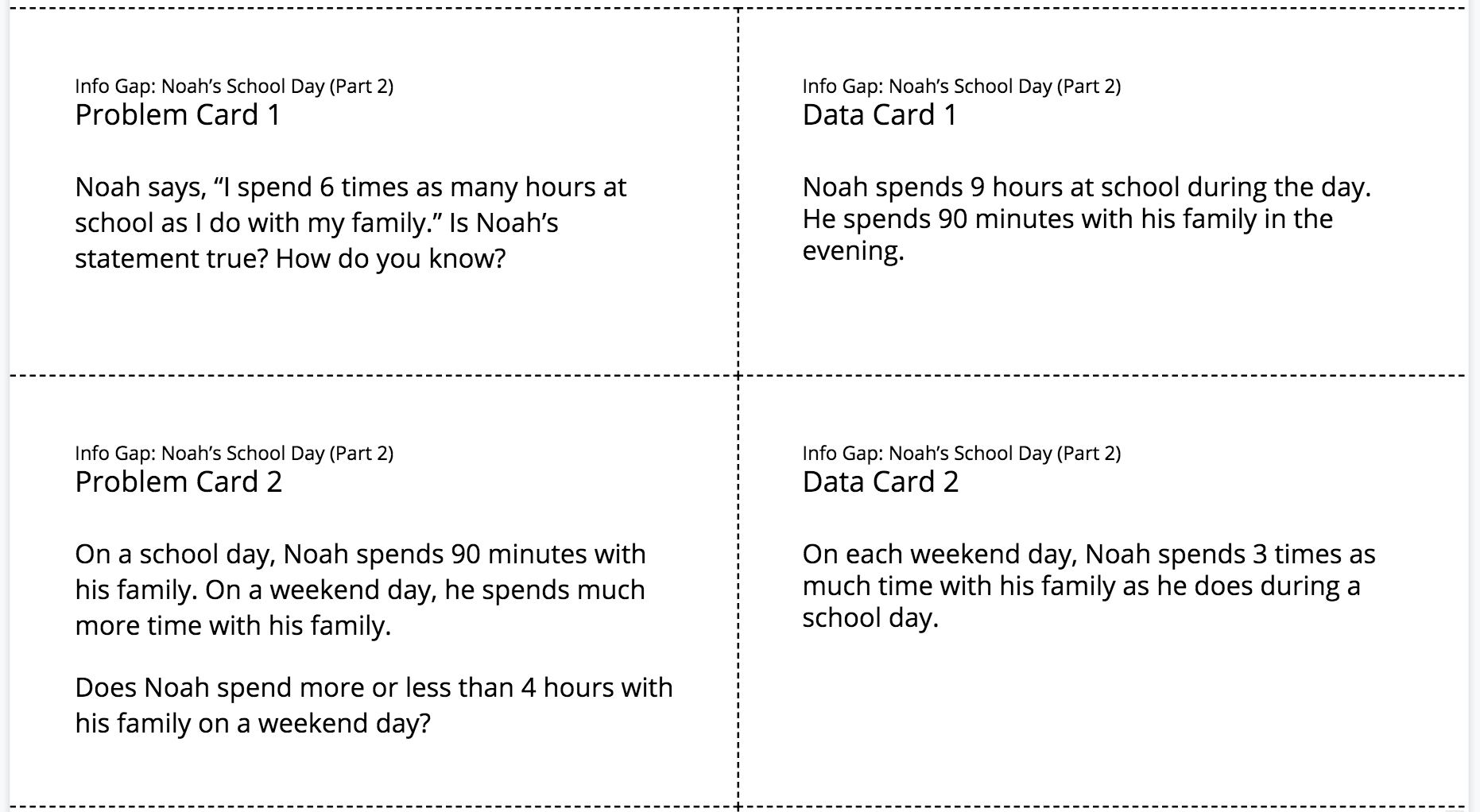
Advances: Reading, Representing
Supports accessibility for: Language, Social-Emotional Functioning
Required Materials
Materials to Copy
- Info Gap: Noah's School Day (Part 2)
Required Preparation
- Create a set of cards from the blackline master for each group of 2.
Launch
- Groups of 2
MLR4 Information Gap
- Display the task statement, which shows a diagram of the Info Gap structure.
- 1–2 minutes: quiet think time
- Read the steps of the routine aloud.
- “I will give you either a problem card or a data card. Silently read your card. Do not read or show your card to your partner.”
- Distribute the cards.
- 1–2 minutes: quiet think time
- Remind students that after the person with the problem card asks for a piece of information, the person with the data card should respond with, “Why do you need to know (restate the information requested)?”
Activity
- 3–5 minutes: partner work time
- After students solve the first problem, distribute the next set of cards. Students switch roles and repeat the process with Problem Card 2 and Data Card 2.
Student Facing
Your teacher will give you either a problem card or a data card. Do not show or read your card to your partner.
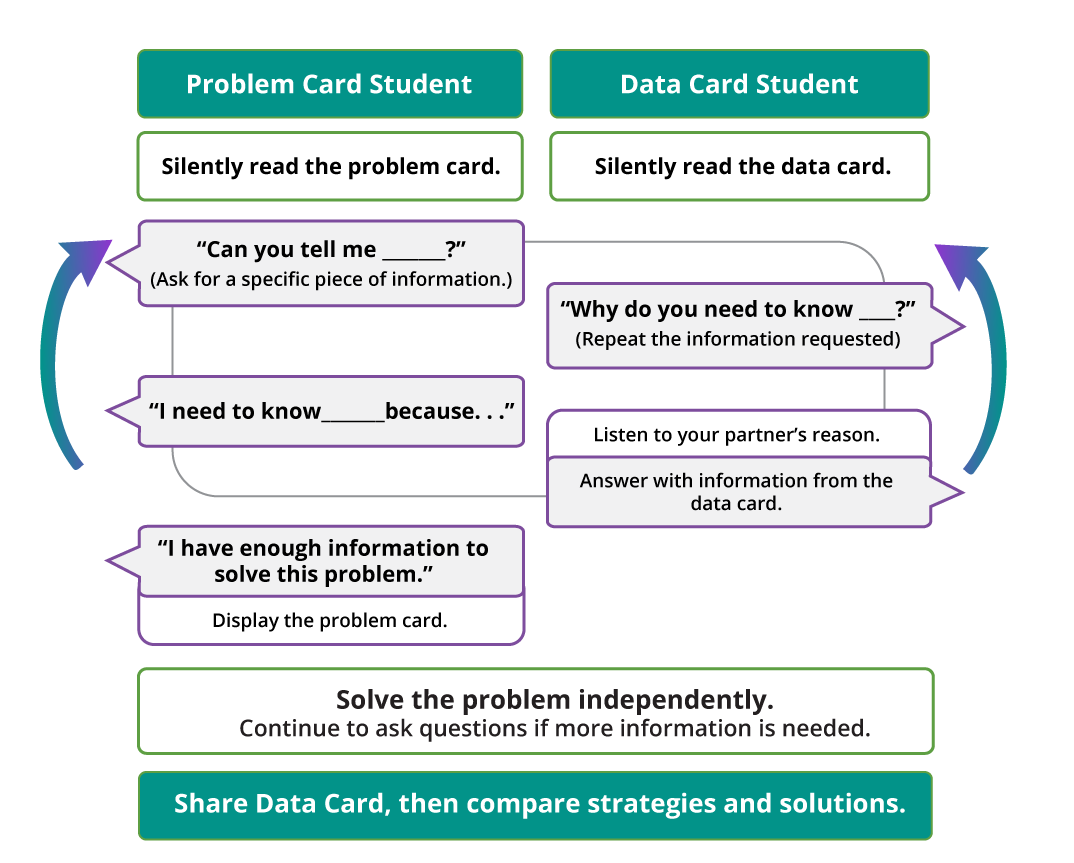
Pause here so your teacher can review your work.
Ask your teacher for a new set of cards and repeat the activity, trading roles with your partner.
Student Response
For access, consult one of our IM Certified Partners.
Activity Synthesis
- “What were the important quantities to know to solve the first problem? What about in the second problem?”
- “Did anyone solve the problem in a different way than their partner?”
- “How did you compare 9 hours and 90 minutes?”
- “How did you find out if Noah spends more than or less than 4 hours with his family on a weekend day?”
Activity 3: Shopping List [OPTIONAL] (20 minutes)
Narrative
This optional activity invites students to apply their knowledge of pounds and ounces and multiplicative reasoning to solve a puzzle about the quantities of ingredients on a shopping list. To solve the puzzle, students need to express pounds as ounces and reason deductively.
As they work to eliminate possibilities, draw conclusions, and explain their thinking to others, students practice constructing logical arguments (MP3).
Launch
- Groups of 2–4
- Read aloud the opening paragraph and the list of ingredients. Invite students to ask any clarifying questions they might have about what was just read.
- Ask students to take turns reading each of the clues and clarify any terms or statements, if needed.
Activity
- “Take a few quiet minutes to read the clues again and to work on the puzzle. Then, discuss your thinking with your group.”
- 5–7 minutes: independent work time
- 5 minutes: group discussion
Student Facing
Here are six ingredients that a shopper bought and some clues about each quantity.
The items are listed in order of weight, from least to greatest.
| ingredient | pounds | ounces |
|---|---|---|
| rice noodles | ||
| shrimp | ||
| tapioca flour | ||
| tofu | ||
| carrots | ||
| brown rice |

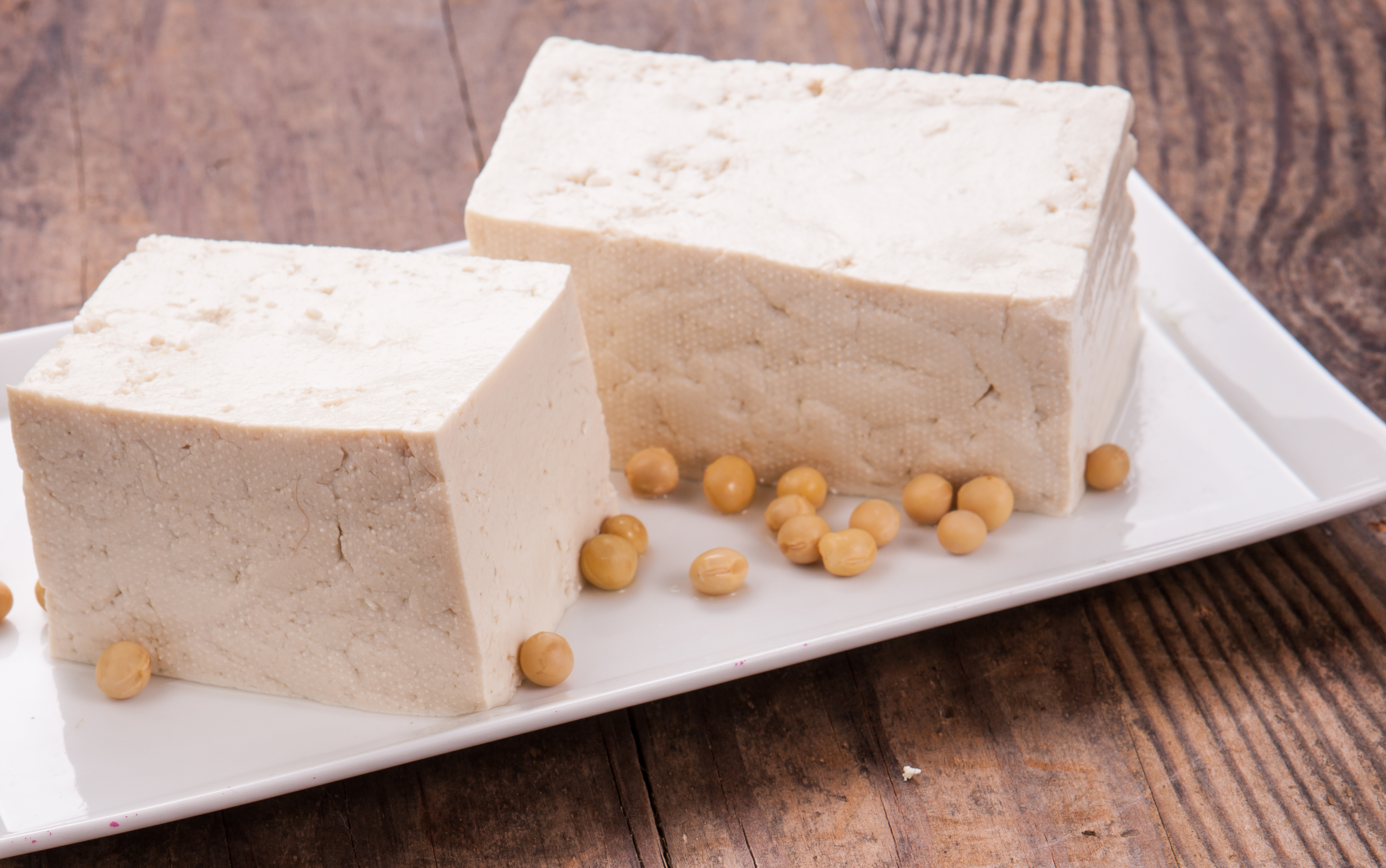
- The heaviest item weighs 4 times the weight of tofu.
- One ingredient weighs \(\frac{1}{2}\) pound.
- The item that weighs 10 pounds is 10 times the weight of shrimp.
- The carrots are 3 times as heavy as the shrimp.
- The carrots are 2 times as heavy as the tapioca flour.
- Brown rice weighs 20 times as much as the weight of noodles.
Use the clues to find out the weight of each ingredient in both pounds and ounces.
Student Response
For access, consult one of our IM Certified Partners.
Activity Synthesis
- Discuss the order in which students completed the missing values. Ask questions such as:
- “Which was the first ingredient whose amount you figured out? Was there a reason you started with that item?” (Rice noodles, because it is lightest and \(\frac{1}{2}\) pound is very light.)
- “Which ingredient and amount did you figure out next?” (Brown rice, because it is 20 times the weight of rice noodles.)
- “Was there a point at which you saw multiple possibilities? How did you decide what to do?” (Any of the items could have been \(\frac{1}{2}\) pound, but if the heaviest amount was \(\frac{1}{2}\) pound, the other ingredients would be very small and not make much sense.)
- “How did you find the weight of the heaviest item? How did you know which one it was?” (I found \(20 \times \frac{1}{2}\).)
Lesson Synthesis
Lesson Synthesis
“Today we solved measurement problems in which not all of the necessary information was provided.”
“How was that experience different from other problem-solving experiences you had so far?” (We had to think about what information was needed, and also about how to ask questions that would give what we needed.)
“What did you find interesting? What did you find challenging?” (We had to explain why we asked for certain pieces of information, which wasn’t always easy.)
Cool-down: Oatmeal Raisin Cookies (5 minutes)
Cool-Down
For access, consult one of our IM Certified Partners.
Student Section Summary
Student Facing
In this section, we learned about various units for measuring length, distance, weight, capacity, and time. We saw how different units that measure the same property are related.
Here are the relationships that we saw:
- One meter (m) is 100 times as long as 1 centimeter (cm).
- One kilometer (km) is 1,000 times as long as 1 meter (m).
- One kilogram (kg) is 1,000 times as heavy as 1 gram (g).
- One liter (L) is 1,000 times as much as 1 milliliter (mL).
- One pound (lb) is 16 times as heavy as 1 ounce (oz).
- One hour is 60 times as long as 1 minute.
- One minute is 60 times as long as 1 second.
When given a measurement in one unit, we can find the value in another unit by reasoning and writing equations. For example, to express 5 kilograms in grams, we can write \(5 \times 1,\!000 = 5,\!000\). To express 4 pounds in ounces, we can write \(4 \times 16 = 64\).
Throughout the section, we used these relationships to convert measurements from one unit to another, to compare and order measurements, and to solve problems in different situations.